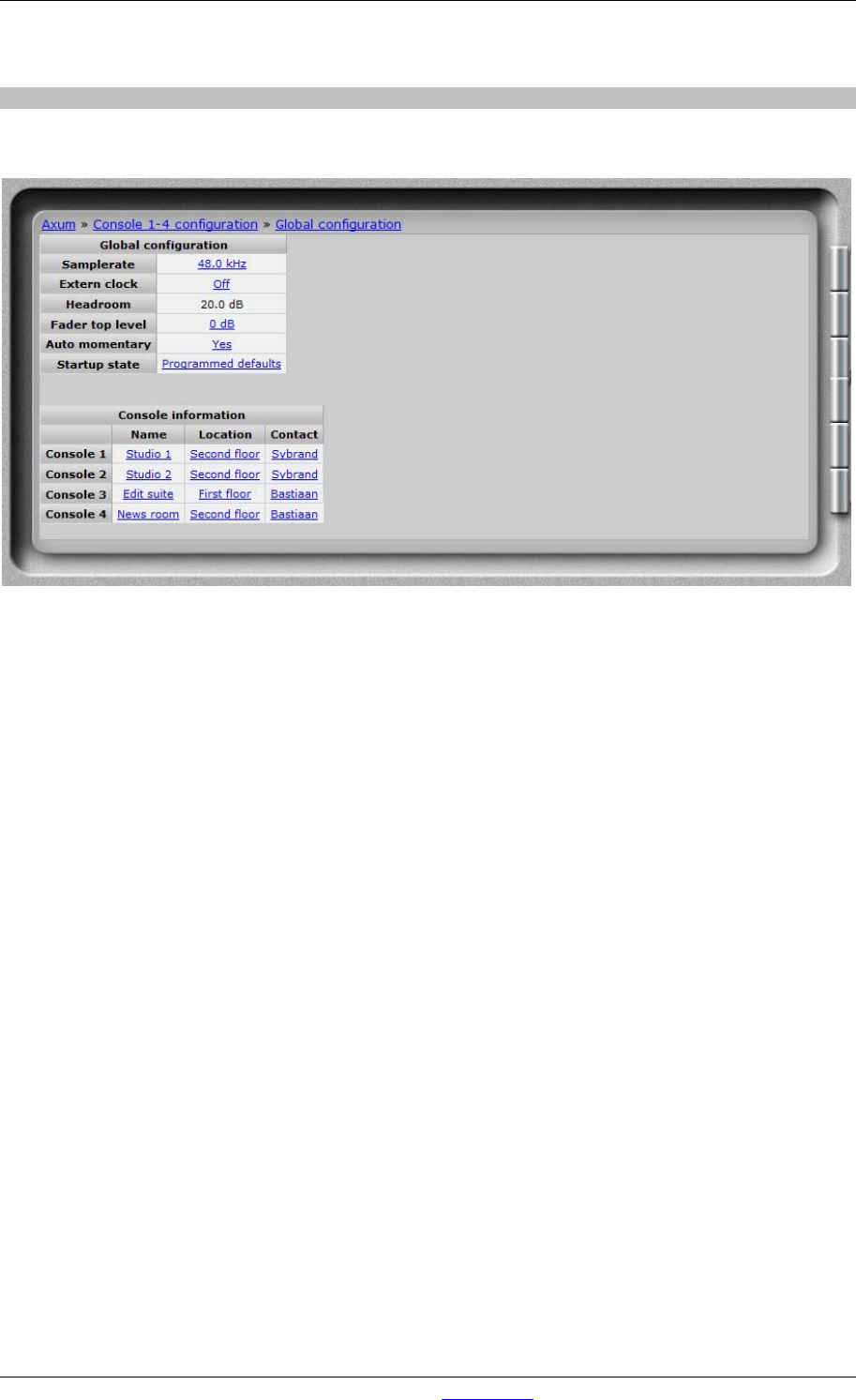User manual
Table Of Contents
- 1 Table of contents1 T
- 2 Package Contents
- 3 Introduction
- 4 System overview
- 5 Control Surfaces
- 6 AXUM Engine
- 6.1 Console 1-4 configuration
- 6.1.1 IP/Clock configuration
- 6.1.2 Global configuration
- 6.1.3 Mix buss configuration
- 6.1.4 Monitor buss configuration
- 6.1.5 Source configuration
- 6.1.6 Extern source configuration
- 6.1.7 Destination configuration
- 6.1.8 Talkback configuration
- 6.1.9 Processing presets
- 6.1.10 Module assignment
- 6.1.11 Module configuration
- 6.1.11.1 Module configuration page
- 6.1.11.2 Module preset 1A/1B, 2A/2B, 3A/3B, 4A/4B
- 6.1.11.3 Processing
- These are the programmed processing defaults for the modules. Depending on the startup settings these processing defaults will be used at startup (programmed defaults in global configuration).The field ‘Use at source select’ determines if the default module processing in the source configuration is used when a source is assigned via the module source select functionality and no processing preset is assigned in the ‘source configuration’.
- The following state/value processing sections are available:
- 6.1.11.4 Routing
- 6.1.11.5 Set module 1 to programmed startup state
- 6.1.12 Mix/monitor buss presets
- 6.1.13 Console presets
- 6.1.14 Surface configuration
- 6.1.15 Rack configuration
- 6.1.16 Source pools
- 6.1.17 Preset pools
- 6.1.18 Users
- 6.2 System configuration
- 6.1 Console 1-4 configuration
- 7 Surface(s) website
- 8 Block diagrams – Must be created
- 9 I/O Rack description
- 10 Available I/O rack cards
- 11 Patch panels
- 12 Specifications AXUM digital audio system
- 13 List Of Figures
- 14 List Of Tables
- 15 Declaration Of Conformity
- 16 Product Safety
- 17 Disclaimer
- 18 Appendix A - Network design for AXUM
- 19 Appendix B – Surface service
- 20 Appendix C – Engine functions

A·X·U·M User Manual Version 2.5 - 2011-01-28
AXUM from D&R - Phone: +31 294 418014 - E-Mail: info@d-r.nl - 19 -
6.1.2 Global configuration
Some overall system settings can be filled in on this webpage.
Figure 7: Global configuration
• Sample rate
You can select a sample rate of 32 kHz, 44.1 kHz en 48kHz. According to this setting, the
filters are setup so you have to make sure to select the sample rate you work with. Also when
using an external clock.
• Extern(al) clock
If you want to use the external clock (Frame clock in) you can turn it on here.
• Headroom
The internal headroom is fixed at 20 dB, to adjust the headroom on a local input/output you
can give an offset level to the sources/destinations or at the rack configuration.
• Fader top level
You can make the fader work with or without 10 dB fader reserve. In the last situation the
faders will be 0 dB (unity gain) when the fader is fully up (maximum position).
• Auto momentary
Most switch functions can work in a auto-momentary mode. When set to yes a knob will
function latching when pressed shortly. But with a long press (>750 mS) the knob reacts like a
momentary switch (function active while pressed).
• Startup state
Here you can select to use a known startup state which is the ‘programmed defaults’ or use a
‘backup of the last situation’.
Programmed defaults are the defaults as setup in the web-configuration. An backup of the
console is saved once a minute, which means you will return to (almost) the last situation.
• Console information
Here you can share some details to have an easier identification in a multi-studio environment.










